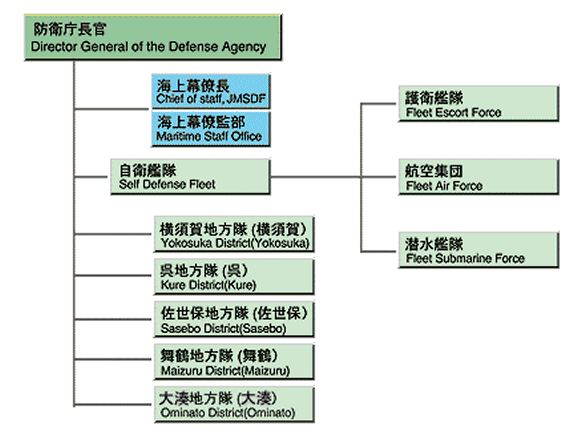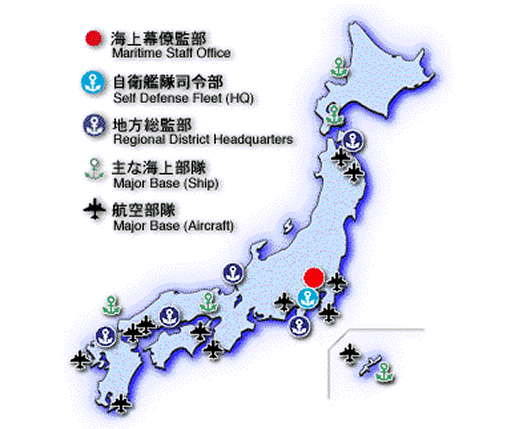





Two kinds of operations are conducted by the Japan Maritime Self Defence Force [JMSDF] for the purpose of defending Japan: securing maritime traffic and securing Japanese territory. For Japan, which relies on foreign countries for the supply of almost all energy and food, the influence to national life is quite serious in case that maritime traffic is cut off. It can also be said that the impact to the world economy is significant in such case. Therefore, the JMSDF must be able to secure maritime traffic against attack by enemy submarines, surface ships and aircraft by effectively combining each operation such as surveillance, escort and defense of ports and straits. In case of aggression which aims at territorial occupation, it is necessary to stop it at sea in order to prevent direct damage to our territory. For that purpose, the JMSDF, in cooperation with the JGSDF and the JASDF, contributes defense of Japan by destroying enemy surface ships aircraft and, according to the situation, laying mines around the expected landing place.
The nation is vitally dependent on maintaining access to regional and worldwide shipping lanes and fishing areas, but it is incapable of defending the sea routes on which it relied. Its energy supplies came primarily from Middle Eastern sources, and its tankers had to pass through the Indian Ocean, the Strait of Malacca, and the South China Sea, making them vulnerable to hostilities in Southeast Asia. Vulnerability to interception of oceangoing trade remained the country's greatest strategic weakness. Efforts to overcome this weakness, beginning with Prime Minister Suzuki Zenko's statement in May 1981 that Japan would attempt to defend its sea lines of communication (SLOC) to a distance of 1,000 nautical miles, met with controversy. Within the Defense Agency itself, some viewed a role for the MSDF in defending the SLOC as "unrealistic, unauthorized, and impossible." Even the strongest supporters of this program allowed that constitutional and other legal restrictions would limit active participation of the MSDF to cases where Japan was under direct attack. Japan could, however, provide surveillance assistance, intelligence sharing, and search-and-rescue support to United States naval forces.
The large volume of coastal commercial fishing and maritime traffic limits in-service sea training, especially in the relatively shallow waters required for mine laying, mine sweeping, and submarine rescue practice. Training days are scheduled around slack fishing seasons in winter and summer--providing about ten days during the year. The MSDF maintains two oceangoing training ships and conducted annual long-distance on-the-job training for graduates of the one-year officer candidate school.
The naval force's capacity to perform its defense missions varies according to the task. MSDF training emphasizes antisubmarine and antiaircraft warfare. Defense planners believe the most effective approach to combating submarines entails mobilizing all available weapons, including surface combatants, submarines, aircraft, and helicopters, and the numbers and armament of these weapons were increased in the Mid-Term Defense Estimate. A critical weakness remains, however, in the ability to defend such weapons against air attack. Because most of the MSDF's air arm is detailed to antisubmarine warfare, the ASDF has to be relied on to provide air cover, an objective that competes unsuccessfully with the ASDF's primary mission of air defense of the home islands. Extended patrols over sea lanes are also beyond the ASDF's capabilities. The fleet's capacity to provide ship-based anti-air- attack protection is limited by the absence of aircraft carriers and the inadequate number of shipborne long-range surface-to-air missiles and close-range weapons. The fleet is also short of underway replenishment ships and seriously deficient in all areas of logistic support. These weaknesses seriously compromise the ability of the MSDF to fulfill its mission and to operate independently of the United States Air Force and the United States Seventh Fleet.
When two North Korean spy boats were later discovered in Japanese territorial waters, Japanese Naval Forces fired their guns in anger for the first time in 54 years.The MSDF is commanded by the chief of the maritime staff and includes the maritime staff office, the self-defense fleet, five regional district commands, the air-training squadron, and various support units, such as hospitals and schools. The maritime staff office, located in Tokyo, serves the chief of staff in command and supervision of the force. The self-defense fleet, headquartered at Yokosuka, is charged with defense of all waters around the Japanese Archipelago. It commands four escort flotillas (two based in Yokosuka and one each in Sasebo and Maizuru), the fleet air force headquartered at Atsugi, two submarine flotillas based at Kure and Yokosuka, two mine-sweeping flotillas based at Kure and Yokosuka, and the fleet training command at Yokosuka.
Five district units act in concert with the fleet to guard the waters of their jurisdictions and provide shore-based support. District headquarters are located in Ominato, Maizuru, Yokosuka, Kure, and Sasebo.


MSDF recruits receive three months of basic training followed by courses in patrol, gunnery, mine sweeping, convoy operations, and maritime transportation. Flight students, all upper-secondary school graduates, enter a two-year course. Officer candidate schools offer six-month courses to qualified enlisted personnel and those who have completed flight school. Graduates of four-year universities, the four-year National Defense Academy, and particularly outstanding enlisted personnel undergo a one-year officer course at the Officer Candidate School at Eta Jima (site of the former Imperial Naval Academy). Special advanced courses for officers are also available in such fields as submarine duty and flight training. The MSDF operates its own staff college in Tokyo for senior officers.
The Maritime Self-Defense Force (MSDF) had an authorized strength in 1992 of 46,000 and maintained some 44,400 personnel and operated 155 major combatants, including thirteen submarines, sixty-four destroyers and frigates, forty-three mine warfare ships and boats, eleven patrol craft, and six amphibious ships. It also flew some 205 fixed-wing aircraft and 134 helicopters. Most of these aircraft were used in antisubmarine and mine warfare operations. The MSDF's former unit structure emphasized anti-submarine and mine warfare.
The National Defense Program Outline which determines Japan's defense capabilities, was reviewed and newly established in December 1995. After reorganization, the MSDF will become a more functionally balanced force capable of conducting a variety of operations ranging from surveillance and patrol in surrounding sea areas to such public welfare support as disaster relief activities. Through a review of the balance between rear and forward units, the MSDF determined the following organizational changes are necessary in order to maximize force effectiveness while optimizing limited resources. First, the number of destroyer units of Regional Districts will be adjusted from ten to seven. Second, two Minesweeper Flotillas will be consolidated into one flotilla and last, the number of land-based patrol aircraft units will be adjusted from 16 to 13.

Submarine units engage in surveillance and defense in major straits. In order to ensure the safety of Japan's maritime transportation, the MSDF needs to maintain the posture capable of deploying two submarines each in the three straits of Soya, Tsugaru and Tsushima, where necessary. In order to maintain such capability, it will be necessary to possess six divisions with 16 submarines, taking into account geographical relations between submarine bases and sea areas where submarines engage in surveillance and defense. The MSDF will maintain six divisions with 16 submarines.
Under the previous Outline, minesweeping units, as ship units which engage in, as necessary, removal and disposal of mines laid in main harbors and straits, were maintained with two minesweeping flotillas one each assigned to the East Japan and West Japan Sea areas, in conformity with Japan's geographical characteristics. Under the new structure of the MSDF, the two flotillas will be unified into one from the viewpoint of maintaining minimum functions.
Under the new Outline, the number of land-based patrol aircraft units was set at 13 squadrons, compared with 16 set in the previous Outline. Broken down into details, 1) fixed-wing patrol aircraft units engaging in surveillance in nearby seas will be reduced to eight squadrons from 10, and 2) land-based patrol helicopter units engaging in surveillance and defense in main harbors and straits will be reduced to five squadrons from six. Aircraft previously called "anti-submarine aircraft" are referred to as "patrol aircraft" in the new Outline because anti-submarine aircraft will engage in extensive surveillance patrols over the sea, not limited to anti-submarine missions. As to fixed-wing patrol aircraft units, the MSDF previously possessed eight squadrons with 80 aircraft needed to conduct patrols at least once a day in Japan's nearby seas where necessary, and two squadrons with 20 aircraft capable of escorting ships. Under the new MSDF structure, the two squadrons with 20 aircraft engaging in the latter mission will be abolished because assignment of patrol aircraft for the escort of ships will no longer be considered from the viewpoint of defense buildup. As to land-based patrol helicopter units, the MSDF previously possessed six squadrons, one each assigned to the two straits of Tsugaru and Tsushima, as well as four regions of Keihan, Hanshin, Japan Sea and Okinawa, to provide defense for straits and harbors. Under the new structure, MSDF will possess five squadrons, one each to five defense districts, from the viewpoint of ensuring the minimum posture and not creating a lack of regional capability. Due to the MSDF structural changes, the number of combat aircraft will be reduced to about 170 from about 220 possessed under the previous Outline.
